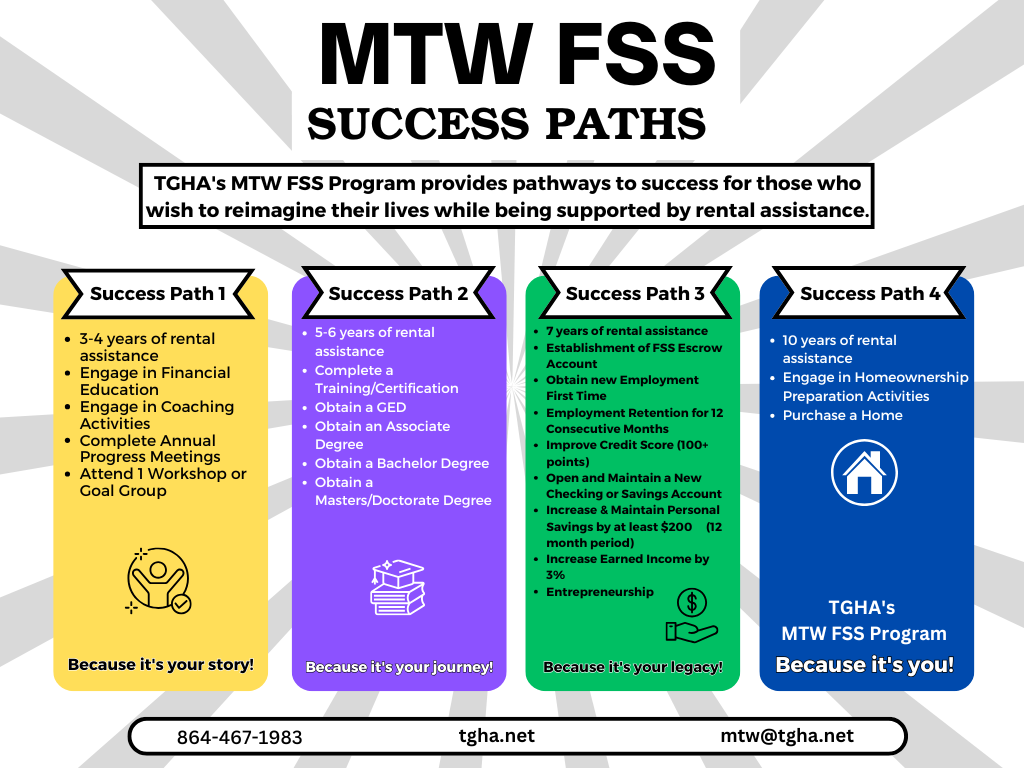CLICK TO VIEW MTW SUPPLEMENT PLAN (pdf)
Connect with Us!
About the MTW Program
The Moving to Work (MTW) demonstration program, established by the U.S. government in 1996, revolutionized housing assistance for low-income households nationwide. MTW empowers selected public housing authorities to devise tailored strategies to efficiently utilize federal funds, promote financial independence among residents, and enhance housing options for low-income families.
Over its more than two-decade existence, MTW agencies have consistently implemented successful initiatives that meet the needs of their communities while expanding opportunities for households. By granting flexibility in federal housing voucher and public housing programs, MTW enables agencies to develop localized solutions.
Initially, the program included 30 public housing authorities, later expanding to 39 by 2015. The Consolidated Appropriations Act of 2016 extended contracts for these agencies for 10 more years and authorized an additional 100 public housing authorities to join. Strong bipartisan support has consistently backed MTW expansions.
In 2021, the Greenville Housing Authority (TGHA) joined the program’s Landlord Incentives cohort, aiming to attract and retain landlords in the Housing Choice Voucher (HCV) Program through financial and administrative incentives. TGHA’s participation underscores the importance of MTW in tailoring programs to community needs and swiftly adapting to market changes.
MTW’s statutory goals include reducing costs, incentivizing employment among households, and increasing housing choices for low-income families. TGHA, serving over 3,291 households recognizes MTW as essential for effective and efficient public service.
For further information on MTW, including designated demonstration sites, visit HUD’s website.
Success Paths

Testimonials

Gloria Gomez
I’ve already benefited from the traditional FSS program by furthering my education and getting a better job. I’m excited to use this new version of FSS to create a brighter future.

Toni Palmer
My name is Toni Palmer, and I chose success path 1. I thought that path best fit what I want my journey to be. I am taking steps to start my own business, so I figured that with financial education and coaching that will help me to succeed.

Catetra Byrd
I joined the 4-year plan (PATH 1). The only reason I did the 4 year is because of my age. To me, this is a great program. I’m excited to become a homeowner. The FSS staff are so easy to work with. They are kind, compassionate, understanding, and really helpful. They have a lot of patience. I wish this program was around when I was younger. Thanks TGHA FOR THIS OPPORTUNITY.

Marshell Roper
In my years of being a client with TGHA, I had never thought about opportunities of not having assistance given to me. I had become complacent and did not know how to come out of complacency, but with FSS now I have a chance of independence and having opportunities to enhance my life in areas I never thought I could receive help. Thank you, TGHA and FSS, for the chance to grow and live independently.
Moving To Work
The Moving to Work (MTW) demonstration program, established by the U.S. government in 1996, revolutionized housing assistance for low-income households nationwide. MTW empowers selected public housing authorities to devise tailored strategies to efficiently utilize federal funds, promote financial independence among residents, and enhance housing options for low-income families.
Over its more than two-decade existence, MTW agencies have consistently implemented successful initiatives that meet the needs of their communities while expanding opportunities for households. By granting flexibility in federal housing voucher and public housing programs, MTW enables agencies to develop localized solutions.
Initially, the program included 30 public housing authorities, later expanding to 39 by 2015. The Consolidated Appropriations Act of 2016 extended contracts for these agencies for 10 more years and authorized an additional 100 public housing authorities to join. Strong bipartisan support has consistently backed MTW expansions.
In 2021, the Greenville Housing Authority (TGHA) joined the program’s Landlord Incentives cohort, aiming to attract and retain landlords in the Housing Choice Voucher (HCV) Program through financial and administrative incentives. TGHA’s participation underscores the importance of MTW in tailoring programs to community needs and swiftly adapting to market changes.
MTW’s statutory goals include reducing costs, incentivizing employment among households, and increasing housing choices for low-income families. TGHA, serving over 3,291 households recognizes MTW as essential for effective and efficient public service.
For further information on MTW, including designated demonstration sites, visit HUD’s website.

Gloria Gomez
I’ve already benefited from the traditional FSS program by furthering my education and getting a better job. I’m excited to use this new version of FSS to create a brighter future.

Toni Palmer
My name is Toni Palmer, and I chose success path 1. I thought that path best fit what I want my journey to be. I am taking steps to start my own business, so I figured that with financial education and coaching that will help me to succeed.

Catetra Byrd
I joined the 4-year plan (PATH 1). The only reason I did the 4 year is because of my age. To me, this is a great program. I’m excited to become a homeowner. The FSS staff are so easy to work with. They are kind, compassionate, understanding, and really helpful. They have a lot of patience. I wish this program was around when I was younger. Thanks TGHA FOR THIS OPPORTUNITY.

Marshell Roper
In my years of being a client with TGHA, I had never thought about opportunities of not having assistance given to me. I had become complacent and did not know how to come out of complacency, but with FSS now I have a chance of independence and having opportunities to enhance my life in areas I never thought I could receive help. Thank you, TGHA and FSS, for the chance to grow and live independently.








